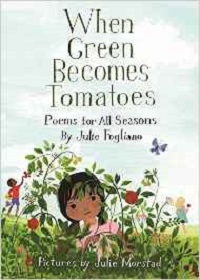| ________________
CM . . .
. Volume XXII Number 14. . . .December 4, 2015
excerpt:
For me, the “proof” that spring has actually arrived is my seeing (not hearing) my first robin. It seems that the poet and I share the same need for visual evidence as she opens her collection of 48 poems with:
The poems, which range in length from april 12's and may 6's two lines to november 17’s 41 lines, are organized first by season and then, within seasons, chronologically by month, with the poem’s “title” being the month and day. Readers will find many opportunities for recognition, whether it’s seeing the debris from march 24's melted snowman, days spent at the beach in August, september 20's reminder to start pulling out sweaters for fall’s colder days, or january 30's snowy day where “there is nowhere to go / but the kitchen / for a cookie”. The poem that provided the book’s title is july 10 which provides a word picture of a tomato plant that is heavy with ripening fruit. A poem that demands to be read on Halloween is october 31 whose seven 4-line stanzas take readers through a pumpkin’s life cycle. The gouache and pencil crayon illustrations of award-winning Julie Morstad effectively capture the content and mood of Fogliano’s poems. Morstad’s multi-racial cast of juvenile characters is delightful, but the artwork does “fight” somewhat with the poetry. While the poetry would appeal to a very wide audience, including adults, Morstad’s “child” characters would make the book appear to be too juvenile for older middle school or junior high students. However, teachers of these older grades might wish to have personal copies for read-aloud purposes. Technically speaking, there is a forty-ninth poem, but the collection concludes on March 20th; and repeats the collection’s opening poem. Though march 20 has exactly the same words, the accompanying illustration is different, thereby serving as a reminder, that, while the seasons repeat themselves, each year also delivers differences. Highly Recommended.
Dave Jenkinson, CM’s editor, lives in Winnipeg, MB.
To comment on this title or this review, send mail to cm@umanitoba.ca.
Copyright © the Manitoba Library Association. Reproduction for personal use is permitted only if this copyright notice is maintained. Any
other reproduction is prohibited without permission.
CM Home |
Next Review |
(Table of Contents for This Issue - December 4, 2015.)
| Back Issues | Search | CM Archive
| Profiles Archive |
